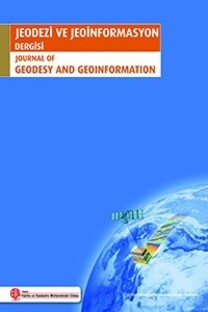LiDAR ve Hava Fotoğrafları ile Otomatik Bina Çıkarımı
LiDAR, Segmentasyon, Hough, Bulanık-mantık, Sınıflandırma
Automatic Building Extractionwith LiDAR and Aerial Photographs
LiDAR, Segmentation, Hough, Fuzzy-logic, Classification,
___
- AMERI B.: Automatic Recognition and 3D Reconstruction of Buildings from Digital Imagery, PhD Thesis, German Geo- detic Commission 526, Institute of Photogrammetry, Stuttgart University, 2000.
- CSANYI N., TOTH C.: Improvement of LiDAR Data Accuracy Using LiDAR Specific Ground Targets, Photogrammetric En- gineering &Remote Sensing, Vol. 73, No. 4, s.385-396, 2007.
- DASH J, STEINLE E, SINGH R. P., BÄHR H. P.: Automatic Bu- ilding Extractionfrom Laser Scanning Data: An Input Tool For Disaster Management. Advances in Space Research, 33, 2004
- DEMİR N., POLI D., BALTSAVIAS E.: Detection of Buildings atAirport Sites Using Images & Lidar Data and a Combination of Various Methods, IAPRS, Vol. 38, Part 3/ W4, s.71-77, Paris, France, 2009
- ELBERINK O.: Acquisition of 3D Topographphy: Automated 3D Road and Building Reconstruction Using Airborne Laser Scanner Data and Topographic Maps, International Institute for Geo-Information Science and Earth Observation, Enscheda, The Netherlands, PhD Thesis, 2010.
- HAALA N., BRENNER C.: Extraction of Buildings and Trees in Urban Environments. ISPRS Journal of Photogrammetry and Remote Sensing,54, s. 130-137, 1999.
- HOUGH P.: Methods and Means for Recognizing Complex Pat- terns. U.S. Patent 3,069,654, 1962.
- KABOLIZADE M., EBADI H., AHMADI S.: An Improved Sna- ke Model for Automatic Extraction of Buildings from Ur- ban Aerial Images and Lidar Data. Computers, Environment and Urban Systems, 2010.
- NAVULUR K.: Multispectral Image Analysis Using the Object- Oriented Paradigm, CRC Press, Taylor & Francis Group,6000 Broken Sound Parkway NW, Suite 300, Boca Raton, FL 33487- 2742, 2007.
- PENG J., ZHANG D., LIU Y.: An Improved Snake Model For Building Detection from Urban Aerial Images. Pattern Re- cognition Letters, 26, s. 587–595, 2005.
- RICHARDS J.A.: Remote Sensing and Digital Image Analysis. Springer-Verlag, Berlin, 1993
- ROTTENSTEINER F., CLODE S.: Building and Road Extracti- on by LiDAR and Imagery. Topographic Laser Ranging and Scanning Principles and processing. Taylor &Francis Group, ISBN 978-1-4200-5142-1, s. 445-478, 2009.
- ROTTENSTEINER F., TRINDER J., CLODE S., KUBIK K.: Bu- ilding Detection by Fusion of Airborne LaserScanner Data and Multi Spectral Images: Performance Evaluation and Sensitivity Analysis, ISPRS Journal of Photogrammetry and Remote Sensing 62, s. 135-149, 2007.
- ROTTENSTEINER F., TRINDER J., CLODE S., KUBIKK.: Using The Dempster–Shafer Method For The Fusion Of LIDAR Data And Multi-Spectral Images For Building Detection, Information Fusion 6, s. 283-300, 2005a.
- ROTTENSTEINER F., SUMMER G., TRINDER J., CLODE S., KUBIK K.: Evaluation of a Method For Fusing LIDAR Data And Mulitspectral Images For Building Detection, IAPRS 36 (Part 3/W24), s.1520, 2005b.
- SITHOLE G.: Segmentation and Classification of Airborne La- ser Scanner Data. Ph.D. Thesis. University of Delft. The Net- herlands. Publications on Geodesy, 59, 2005.
- TARSHA-KURDI F., LANDES T., GRUSSENMEYER, P.: Hough Transform and Extended RANSAC Algorithms For Auto- matic Detection Of 3D Building Roof Planes From Lidar Data. IAPRS, Vol. 36, Part 3/ W52. s.407-412, 2007.
- VOSSELMAN G., SESTER M., MAYER H.: Basic Computer Vision Techniques. Manual Of Photogrammetry.American So- ciety for Photogrammetry and Remote Sensing (ASPRS), Fifth edition. s. 455-504, 2004.
- YAN G.: Pixel Based and Object Oriented Image Analy- sis for Coal Fire Research. MasternThesis. ITCThe Netherlands,2003.
- ZEVENBERGEN L., THORNE C.: Quantitative Analysis of Land Surface Topography, Earth Surface Processes and Landforms 12, s. 47–56, 1987.
- ZHANG K., YAN J., CHEN S.: A Framework for Automated Construction of Building Models from Airborne LiDAR Measurements. Topographic Laser Ranging and Scanning Principles and processing. Taylor & Francis Group, ISBN 978- 1-4200-5142-1, s. 511-534, 2009.
- ISSN: 2147-1339
- Yayın Aralığı: Yılda 2 Sayı
- Başlangıç: 2012
- Yayıncı: TMMOB Harita ve Kadastro Mühendisleri Odası
Çoklu Frekanslı GNSS Ölçüleri İle Anlık Bağıl Konum Belirlemede Stokastik Model Oluşturma
Dünyada Üç Boyutlu Kadastro Uygulamaları
Fatih DÖNER, Cemal BIYIK, Osman DEMİR
Yüzeylerin Pürüzlülük Açılarının Lazer Tarayıcılar Yardımıyla Belirlenmesi
Umut AYDAR, Emin Özgür AVŞAR, Şinasi KAYA, Erkan BOZKURTOĞLU, Dursun Zafer ŞEKER
Hassas Nokta Konumlama Tekniğinin Hidrografik Ölçmelerde Kullanılabilirliği
Reha Metin ALKAN, Yunus KALKAN
Portal Teknolojisi ve Ulusal Konumsal Veri Altyapısı
Muhammet Emre YILDIRIM, Çetin CÖMERT, Portal TEKNOLOJİSİ
İzmir Coğrafi İmar Bilgi Sistemi
Çok Ölçütlü Karar Destek Sistemleri ile Taşınmaz Değerleme ve Oran Çalışması
Tuzla Fayı ve Civarında Yerkabuğu Hareketlerinin Jeodezik Yöntemler ile İncelenmesi
Haluk ÖZENER, Aslı DOĞRU, Esen ARPAT, Mustafa ACAR, Bülent TURGUT, Onur YILMAZ, Kerem HALICIOĞLU, Aslı SABUNCU, Emre HAVAZLI
GNSS Verisinin Gerçek Zamanlı İletimi İçin Uluslararası Standartlar ve Gelişmeler
